It seems they’re everywhere: in virtually every cafe, coffee bar and coffee house in the country and even at such low-profile operators as Dunkin Donuts and the self-serve coffee stations at 7-11 Food Stores. As night follows day, so have a plethora of cold coffee drinks joined their hot, freshly brewed brethren into consumer consciousness.
With a steadily-increasing array of offerings–everything from iced coffee to milkshake-like confections to sophisticated bar drinks, combinations of coffee and ice are the latest development in the gourmet-coffee boom.
Category dominator Starbucks, the largest coffee-bar chain in the country, introduced its signature frozen coffee drink Frappuccino in 1995. “Overnight, it doubled cold coffee sales,” says chain spokesman Rob Volpe. And when introduced to the retail market a year later, Frappuccino alone grew the market for ready-to-drink coffee products by more than 150%. Currently, the Applebee’s casual dining chain is testing Frappuccino in a number of its Kansas restaurants, while the Starbucks chain continues to offer it in a growing number of versions–everything from the vitamin-, carbohydrate- and protein-bolstered Power Frappuccino designed for the health conscious, to an Espresso Frappuccino for the caffeine conscious. Starbucks successfully hawks raspberry- and hazelnut-flavored Frappuccinos and is in the midst of rolling out a vanilla Frappuccino to its retail offerings.
Although the full-service restaurant industry as a whole has been slower to add iced and frozen coffees to their menus, some operators are out in front of the curve.
In addition to testing the Starbucks Frappuccino for its summer beverage menu, Applebee’s has sold frozen coffee drinks nationwide since 1994, including its own Frozen Cappuccino.
At New York’s acclaimed upscale Gramercy Tavern, general manager Nick Mautone has put a sophisticated spin on iced coffee for the coming summer, including an iced macchiato (espresso served with a dot of foam.) The Gramercy Tavern version is an iced double espresso combined with Talenti grappa, served with ice cubes made of chocolate sorbet.
Taking The Plunge
Cold coffee drinks can be divided into two main categories: iced, in which any coffee is cooled and served over ice, with or without some form of cream or sugar; and frozen coffee. Frozen coffees, in turn, fall into two main camps: coffee-flavored granitas, which have been described as “upscale slushies;” and blended coffee drinks, which resemble milkshakes.
Many experts say that the frozen coffee drinks are far more popular than iced coffee today, with some estimating that up to 80% of all the cold coffees sold in foodservice settings are frozen.
As the interest in cold coffee drinks has blossomed, so has the variety of offerings. While such restaurants as Gramercy Tavern concoct their cold coffee drinks from scratch, many others use mixes. “Most in foodservice will, for the foreseeable future, be using some type of powdered mix,” says Ted Lingle, director of the Specialty Coffee Association of America. “In the ’70s, which wasn’t so long ago, most [foodservice operations] made their iced tea from mixes. It was only in the early ’80s that they switched over to making their own,” he says. “I think frozen coffees will go along the same path.”
The attraction for both consumers and operators for the various frozen coffees, non-dairy granitas and dairy-based blended drinks can be readily understood.
The non-dairy drinks can easily be mixed in granita machines and other contemporary frozen drink dispensers, depending on local health- department regulations.
Granita machines, while similar to traditional frozen-drink units, are also usually clear so customers can see the beverages. That, combined with the machine’s constant mixing action, make for “a marketer’s dream,” says Donald Harrell, vice president, national accounts for Monin Syrups, whose products are used to flavor coffee drinks of all types.
And because the granita machine beverages are made in batches rather than individually, these small-capacity machines can help an operation handle greater sales volume more easily. But granita machines are also expensive compared to blenders, from $2,500 for a single-drink machine to $3,500 for a three-drink unit.
Mixing It Up
While a high-volume operator may prefer the time-saving properties of a granita machine, other operators prefer to make their frozen coffee drinks to order with blenders.
“If you have it in a machine, you have to sell it right away anyway, within a day or two,” says Pete Gallanis, owner of Cameron’s Seafood, a California restaurant that serves a wide variety of frozen coffee drinks derived from mixes provided by Pasadena-based Caffe D’Amore. Frozen cappuccinos are the most popular frozen coffee at Cameron’s, but Galanis points out that the restaurant can accommodate any customer request, adding liquor or even fruit to make a unique drink.
Indeed, mix companies and restaurateurs say that the mixes currently on the market increase creativity.
“Some food items just become accepted as an ingredient, like ketchup. We want operators to use our products the same way,” says Richard Principale, national sales director for Laguna Niguel, CA-based mocha mix specialist Mocafe. “Just using a blender, a restaurant can come up with literally dozens of coffee concoctions.”
Some mix products can be altered by introducing different liquids, most commonly water, coffee or milk. Principale has even used Starbucks coffee-flavored Double Black Stout by Redhook Ale Brewery with Mocafe mixes.
And with an explosion of flavored syrups, including creme br




